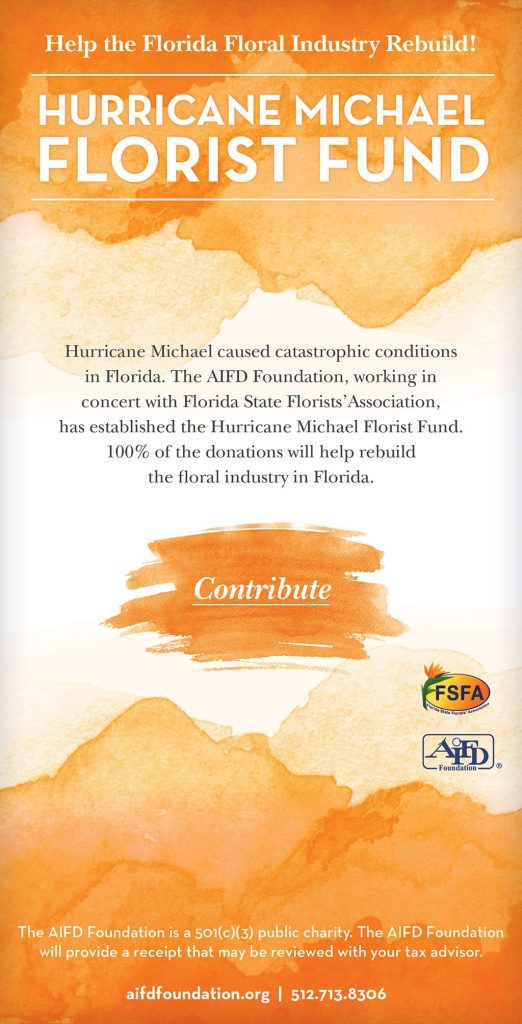
The AIFD Foundation, in concert with the Florida State Florists’ Association (FSFA), this week established the Hurricane Michael Florist Fund “to help rebuild the Florida floral industry,” said CEO Lynn Lary McLean, AIFD.
A week after Hurricane Michael hit Florida’s panhandle as a Category 4 storm, rescue efforts remain underway in some of the hardest hit areas, and floral industry groups have sprung into action to help support businesses devastated by the storm.
The AIFD Foundation, in concert with the Florida State Florists’ Association (FSFA), this week established the Hurricane Michael Florist Fund “to help rebuild the Florida floral industry,” said CEO Lynn Lary McLean, AAF, AIFD, PFCI, TMF.
The new fund “will provide 100 percent of the received contributions for distribution to those in need,” McLean said. “We look to the floral industry to be most supportive of this effort with the hope to assist those with the greatest need.”
Last year, in concert with Texas State Florists’ Association, the AIFD Foundation distributed $56,295 to industry members through the Hurricane Harvey Florist Fund. In partnership with FSFA, the Foundation also provided $15,625.00 in relief via the Hurricane Irma Florist Fund. (Read more about those funds.)
Bob Tucker, AIFD, FSMD, FSFA’s executive director, said his group welcomed the opportunity to work alongside the AIFD Foundation again, even as the extent of the damage from Hurricane Michael remains unknown. Since the storm hit a week ago, Tucker has been trying to find out about member florists in the direct path of the storm, many of whom have not yet been able to return to their businesses and homes.
“At this point, places like Mexico Beach are still just totally devastated,” he said. “The damage there has not even been fully assessed, and it may not be for quite some time.”
At press time, the storm was estimated to have killed 29 people in Florida, Georgia, North Carolina and Virginia.
Ben Bolusky, CEO of the Florida Nursery, Growers and Landscape Association, shared a similar perspective, noting that the storm took down 70 percent of cell towers in some hard-hit counties.
“In the area where Hurricane Michael made landfall, power is out and will be for some time,” he said. “So, it’s challenging to get accurate reports.”
Bolusky added that “while there will likely be a loss of some plant material and there was some scattered structural damage, the nurseries have already been in clean-up mode: standing up plants and trees. The biggest need is power, followed quickly by the need for fuel to run generators so the irrigation systems can do as intended.”
He said he expects it to take days, or even weeks, “to assess the true extent of any damage or disruption.” In the meantime, FNGLA has established four staging areas at member nurseries, two in South Florida and two in the central part of the state, to receive supply, material and equipment donations. (The group also has a page dedicated to supplying members with hurricane-related information.)
“Over the next couple of days, donated trucks and drivers will deliver these materials to North Florida FNGLA member nursery staging areas in the Big Bend area ,” Bolusky explained. The group also may work with former FNGLA president and current state Rep. Halsey Beshears, whose constituents “were among the hardest hit,” according to Boluksy.
Individual industry members also are doing their part to support those devastated by the storm.
As she did last year after hurricanes Harvey and Irma, Deborah De La Flor, AIFD, PFCI, of De La Flor Gardens in Cooper City, Florida, has been coordinating an effort alongside industry wholesalers, growers and transportation companies to deliver nonperishable food, bottled water, toiletries and other needed supplies to victims of the storm.
“Once again, we find ourselves dealing with mother nature at her absolute worst, Hurricane Michael!” she posted to her Facebook page. “We were fortunate enough to be out of harm’s way, but our friends in the Florida Panhandle were not so lucky.”
Look for more coverage of the storm in future issues of EBrief and Floral Management.
Mary Westbrook is the editor in chief of Floral Management magazine.

